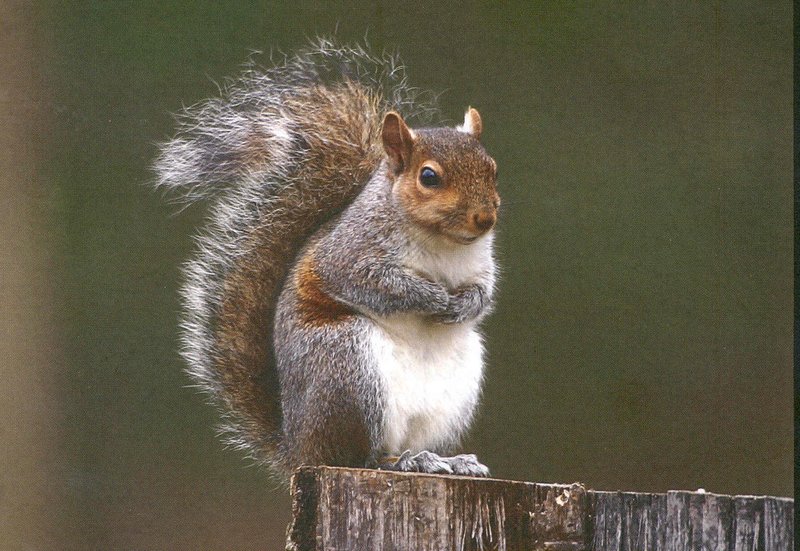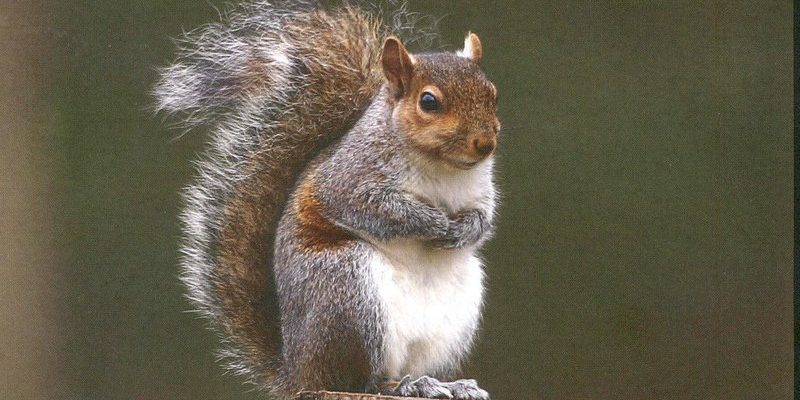
The Eastern Gray Squirrel is one of those charming animals you probably see hopping around your backyard or in local parks. With its bushy tail and lively antics, it’s hard not to smile when these little critters scurry by. But there’s more to them than just their adorable looks. These squirrels are fascinating creatures with unique behaviors, habitats, and diets that play significant roles in their ecosystems.
You might wonder what makes the Eastern Gray Squirrel so special. For one, they are highly adaptable and can thrive in both urban and rural environments. They’ve learned to navigate our human world, often finding ways to snatch birdseed from feeders or expertly dodge cars in busy streets. Their intelligence and resourcefulness contribute to their success as a species, and it’s a joy to watch them go about their daily routines.
Physical Characteristics
The Eastern Gray Squirrel has a few distinctive physical traits that help it stand out. Adult squirrels typically weigh between 1 to 1.5 pounds and measure about 18 to 20 inches long from head to tail. Their fur is predominantly gray, though some may have a reddish-brown tint, especially in certain regions. In the winter, their fur can appear fluffier as they prepare for colder temperatures, while their bushy tails serve multiple purposes, like balancing on branches and keeping them warm.
One of the defining features of these squirrels is their large, expressive eyes, which give them excellent vision. They also have sharp claws that allow them to effortlessly scale trees and leap from branch to branch. Such agility is crucial for escaping predators and foraging for food. Their strong hind legs are built for jumping, helping them move quickly when necessary.
Habitat and Range
The Eastern Gray Squirrel primarily inhabits wooded areas, parks, and suburban settings across the eastern United States and parts of Canada. They thrive in environments with plenty of trees, as these provide shelter and a rich source of food. Squirrels are known to nest in tree hollows or build dreys—spherical nests made of twigs and leaves—in tree branches. These nests offer protection from the elements and predators.
As we expand our cities, the Eastern Gray Squirrel has adapted well. They often use urban areas not only as living spaces but as foraging grounds. You might find them rummaging in gardens or enjoying the seeds from bird feeders. Their flexibility in habitat choice is a key factor in their survival and proliferation.
Diet and Foraging Behavior
When it comes to meals, Eastern Gray Squirrels are primarily herbivores. Their diet mainly consists of nuts, seeds, fruits, and even the occasional small insect or bird egg. They have a particular fondness for acorns, which are abundant in many of their habitats. This love for nuts also leads them to bury their food in various locations—a behavior known as caching. This is a crucial survival tactic that enables them to store food for the winter months.
You might be surprised to learn that these squirrels have an exceptional memory, helping them locate their buried treasures. However, not all cached nuts are retrieved, which ultimately allows for new trees to sprout—an unintentional but beneficial impact on their environment. Watching them actively dig and bury their food can be both entertaining and educational, revealing their role as nature’s gardeners.
Social Behavior
The social dynamics of the Eastern Gray Squirrel are quite interesting. These animals are known for their playful interactions, often chasing each other up and down trees. While they can be solitary, especially when foraging, they also engage in social behaviors. For instance, during mating season, males will compete for the attention of females, showcasing physical prowess and agility.
These squirrels communicate through a series of vocalizations, including chirps, barks, and whistles. Each sound can convey different messages, whether it’s alerting others about a predator or signaling the presence of food. Their ability to adapt and thrive in social settings is a testament to their intelligence and resourcefulness.
Reproduction and Lifespan
Breeding for the Eastern Gray Squirrel typically occurs twice a year, in late winter and summer. After a gestation period of about 44 days, female squirrels give birth to a litter of three to six babies, called kits. These tiny, hairless creatures are completely dependent on their mother for the first few weeks of life. The mother will nurse them until they are ready to venture out and explore their surroundings.
The young squirrels leave the nest around 8 to 10 weeks old, but they often stay close to their mother for a bit longer as they learn vital survival skills. In the wild, Eastern Gray Squirrels can live up to 6 to 12 years, depending on various factors such as predation, habitat, and food availability. However, many do not survive their first year due to various threats, emphasizing the challenges they face despite their adaptability.
Conservation Status
Currently, the Eastern Gray Squirrel is not considered endangered. In fact, their population is stable and, in many areas, thriving. Their adaptability to human environments has allowed them to flourish even amidst urban development. However, like all wildlife, they face threats that can impact their habitats and food sources, such as habitat loss and climate change.
Conservation efforts focus primarily on maintaining healthy ecosystems where these squirrels can thrive. It’s essential to protect their natural habitats and promote sustainable practices that support biodiversity. Urban dwellers can also play a role by creating welcoming environments for wildlife, including providing natural food sources and shelter in their gardens.
Interesting Facts
| Scientific Name: | Sciurus carolinensis |
| Size: | 18-20 inches (including tail) |
| Weight: | 1-1.5 pounds |
| Life Span: | 6-12 years in the wild |
| Diet: | Nuts, seeds, fruits, small insects |
| Habitat: | Wooded areas, parks, urban settings |
| Behavior: | Social, playful, agile |
FAQ
What do Eastern Gray Squirrels eat?
The diet of Eastern Gray Squirrels is quite varied, primarily consisting of nuts, seeds, fruits, and occasionally insects. They are particularly fond of acorns and will often gather and bury them for later. These squirrels play a crucial role in their ecosystem by helping to spread tree seeds.
How can I attract Eastern Gray Squirrels to my yard?
If you want to see more Eastern Gray Squirrels in your yard, consider providing food sources like bird feeders filled with nuts or seeds. Creating a natural space with trees, shrubs, and hiding spots can also encourage them to visit. Just be sure to observe from a distance, as they can be skittish around humans.
Are Eastern Gray Squirrels dangerous?
Generally, Eastern Gray Squirrels are not dangerous. They tend to avoid human contact and prefer to stay in trees or away from people. However, they can carry diseases, so it’s best to admire them from afar rather than trying to handle them. They can also become aggressive if they feel threatened, especially during mating season.
How do Eastern Gray Squirrels communicate?
These squirrels have a range of vocalizations, such as chirps, barks, and whistles, to communicate with each other. Each sound serves a different purpose, from warning others about predators to signaling the presence of food. Observing their interactions can be quite entertaining and informative.
What is the lifespan of an Eastern Gray Squirrel?
In the wild, Eastern Gray Squirrels can live between 6 to 12 years. However, many do not survive their first year due to the many predators and dangers they face. Their ability to adapt to various environments, including urban areas, has contributed to their success as a species.
How do Eastern Gray Squirrels adapt to urban environments?
These squirrels are incredibly adaptable. They find food sources in urban areas, such as bird feeders and gardens, and can nest in trees or even attics. Their resourcefulness and intelligence help them navigate the challenges of living close to humans while still thriving in their natural behaviors.
Do Eastern Gray Squirrels hibernate?
No, Eastern Gray Squirrels do not hibernate. Instead, they remain active throughout the winter, foraging for food and relying on their caches of nuts for sustenance. Their thick fur helps them survive the colder temperatures.
What are the main predators of Eastern Gray Squirrels?
Eastern Gray Squirrels face several predators, including hawks, owls, coyotes, and domestic cats and dogs. Their agility and quick reflexes help them evade these threats, but they are always on the lookout for danger.
Can Eastern Gray Squirrels swim?
Yes, Eastern Gray Squirrels are capable swimmers. If they find themselves in a situation where they need to cross a body of water, they can paddle their way across. Although they prefer to stay on land, their swimming ability can come in handy when necessary.
What is the significance of Eastern Gray Squirrels in the ecosystem?
These squirrels play an essential role in their ecosystem by helping to disperse seeds through caching. When they bury nuts and seeds, some remain underground and eventually sprout, leading to the growth of new trees. This unintentional behavior contributes to forest regeneration and biodiversity.
How do I tell the difference between Eastern Gray Squirrels and other squirrels?
Eastern Gray Squirrels can be distinguished from other species by their gray fur, bushy tail, and size. For example, Fox Squirrels are larger and have a rustier coloration, while Red Squirrels are smaller with a more reddish tint. Observing their habitats and behaviors can also help you identify the specific species.

